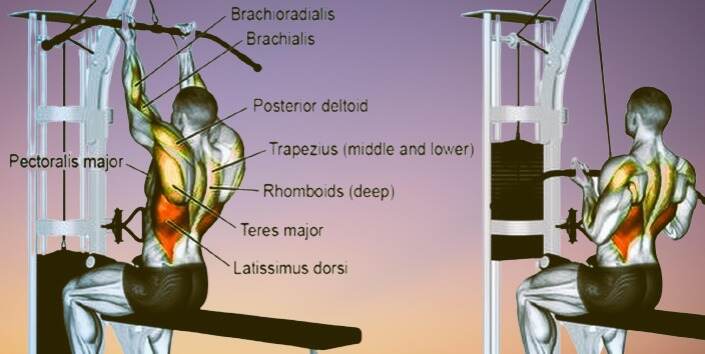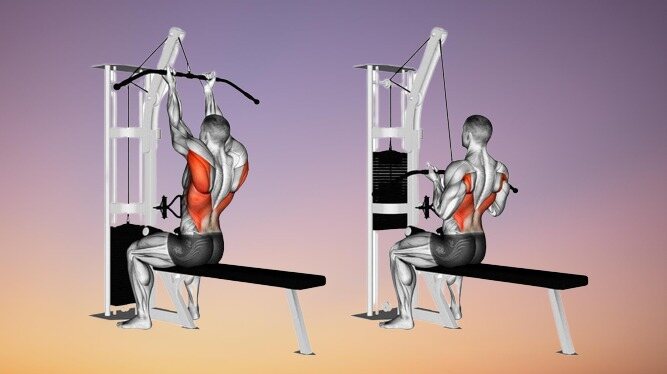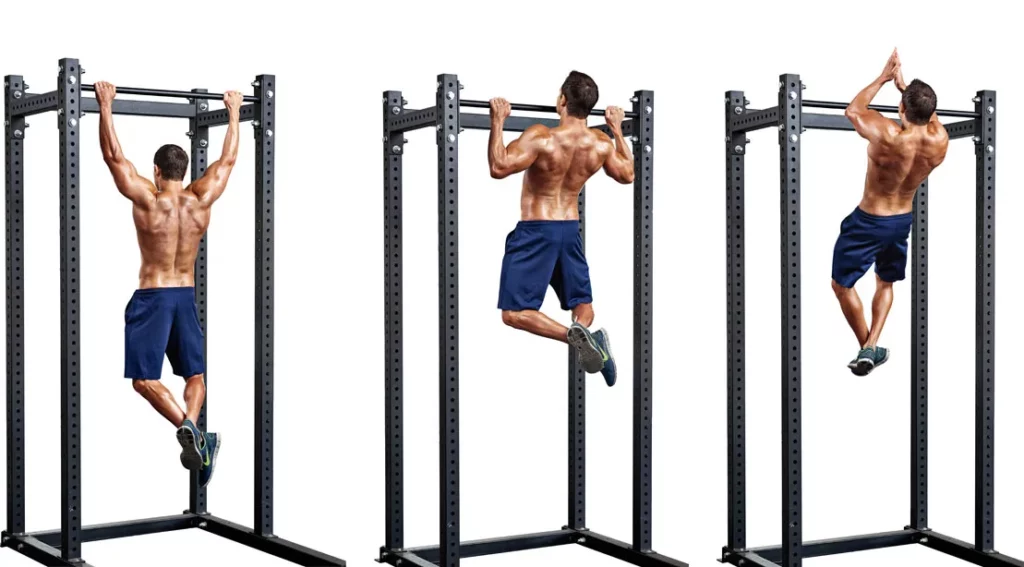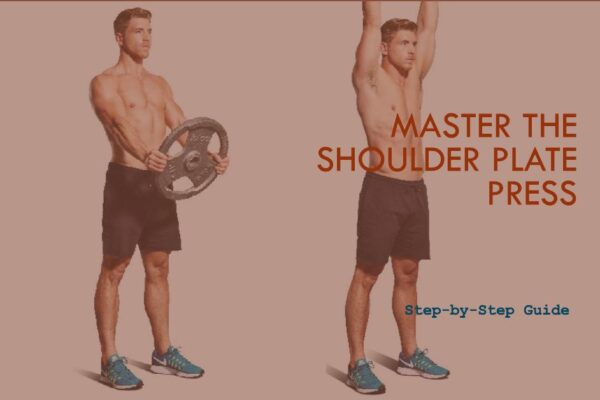Many people suffer from posture issues and back pain, often caused by weak back muscles. To strengthen the back, it’s crucial to incorporate various exercises. One highly effective exercise is the reverse grip lat pulldown.
What is Reverse Grip Lat Pulldown?
The reverse grip lat pulldown is a weight training exercise in which you use a cable machine or pulldown machine to pull a bar down towards your chest with your palms facing you. The reverse grip lat pulldown, also known as the reverse grip pulldown, effectively targets the latissimus dorsi muscles (Lats). It builds back muscles and enhances lower back stability. This exercise primarily activates the lats but also involves the biceps and middle back to a reasonable extent.

Importance of Reverse Grip Lat Pulldown
The reverse grip lat pulldown is an important exercise that primarily targets the back muscles, making them stronger while improving overall back strength and posture. It also enhances lower back stability, activates the biceps, and introduces various reverse grip lat pulldown variations for continuous muscle growth. Incorporating this exercise into your workout routine can help you achieve your fitness goals.
By the end of this article, you will learn about proper form, variations, how to perform it, ways to avoid common mistakes, and tips to maximize results.
Muscles Worked by Reverse Grip Lat Pulldown
The reverse grip lat pulldown primarily targets the following muscles:
- Latissimus dorsi (Lats)
- Biceps brachii (Biceps)
- Rhomboids
- Trapezius (Upper and middle fibers)
- Posterior deltoids (Rear shoulders)
- Teres major
- Lower back muscles (Erector spinae)
- Forearms (Brachioradialis and forearm flexors)
- Pectoralis major (Upper region)
These muscles are actively engaged during the exercise, making it a comprehensive upper-body workout.

Reverse Grip Lat pulldown Benefits
Strength
This exercise strengthens your back muscles.
Posture
Reverse grip lat pulldown corrects forward head and rounded back posture by training your body to depress and adduct the shoulder blades, leading to a straighter posture and a more confident figure.
Lower Back Stability
Strengthening the latissimus dorsi muscles stabilizes your lower back.
Improved Exercise Performance
It enhances your ability to perform exercises like chest presses, squats, chin-ups, and deadlifts more effectively.
Back Pain Relief
The reverse grip lat pulldown can alleviate back pain, particularly pain associated with an unstable lower back.
Step by Step Instructions

Reverse grip lat pulldown is an essential exercise for your back muscles. Wondering how to do the reverse grip lat pulldown on the machine? Here, I will outline the correct method for its execution.
Proper Setup and Starting Position
- Sit on the lat pulldown machine.
- Attach a wide grip handle to the machine.
- Assume a seated position.
Execution of the Concentric and Eccentric Phases
- Grasp the bar with a shoulder-width supinated (reverse or underhand) grip (palms facing you).
- Exhale as you pull the bar down until it touches your upper chest, squeezing your back muscles, and hold for a count of two.
- Inhale as you return the bar to its initial position.
Breathing Techniques During the Exercise
- Exhale during the pulling phase.
- Inhale during the return to the starting position.
- Repeat this exercise for your desired number of repetitions.
Reverse Grip Lat Pulldown Mistakes
If you’re new to this exercise, avoid these errors
Improper Posture
Maintain a neutral lower back and shoulder position for correct execution and optimal benefits.
Pulling the Bar Behind the Neck
Avoid pulling the bar behind the neck to prevent potential injuries and ensure effective at targeting. Keep the bar in front of you.
Bringing the Bar Below Chest Level with Elbows Flaring Out
Keeping the bar too low allows the elbows to flare out, reducing lat tension and bringing the shoulders forward. Keep your elbows close to your body for maximum contraction.
Grabbing the Bar Too Wide
A wide grip limits the range of motion and can strain the shoulder joint. Avoid gripping the bar excessively wide.
Variations of Reverse Grip Lat Pulldown
The reverse grip lat pulldown is a great exercise for targeting various muscle groups in the upper body, but other exercises can provide similar benefits. If you’re looking to switch things up or add some variety to your workouts, here are some alternative exercises that you can try:
Wide Grip Lat Pulldown:
This variation involves using a wider grip on the lat pulldown bar, which can help to target the outer back muscles. It also allows for a deeper stretch in the lats and can be beneficial for those looking to improve their overall back width.
- Sit down on a lat pulldown machine and adjust the thigh pads to secure your legs in place.
- Grab the lat pulldown bar with a wide grip, slightly wider than shoulder-width apart.
- Position your upper body with a slight lean back, keeping your chest up and shoulders back.
- Keep your feet flat on the ground, shoulder-width apart, and maintain a stable position throughout the exercise.
- Take a deep breath and engage your core muscles.
- Start the movement by pulling the bar down towards your upper chest, driving your elbows down and back.
- Keep your back straight and focus on squeezing your shoulder blades together as you pull the bar down.
- Pause for a moment when the bar is near your upper chest, feeling the contraction in your back muscles.
- Slowly release the bar back to the starting position, extending your arms fully and feeling a stretch in your lats.
- Repeat the movement for the desired number of repetitions, maintaining control and proper form throughout the exercise.
- Remember to breathe consistently throughout the exercise, exhaling as you pull the bar down and inhaling as you release it back up.
- As you progress, you can increase the weight gradually to challenge your back muscles further.
Note: It is important to consult with a fitness professional or trainer to ensure proper form and technique while performing this exercise.
Incline Bench Barbell Row
The Incline Bench Barbell Row is a strength training exercise that targets the muscles in your back, particularly the latissimus dorsi (lats) and the rhomboids. Here’s how you perform it:
Equipment Needed: An incline bench and a barbell.
Step-by-Step Instructions:
- Set Up the Bench: Adjust the incline bench to about a 45-degree angle.
- Position Yourself: Lie face down on the bench, with your feet firmly on the floor for stability. Your chest should be at the top of the bench.
- Grip the Barbell: Reach down and grab the barbell with an overhand grip, hands slightly wider than shoulder-width apart.
- Perform the Row: Keep your body tight and pull the barbell up towards your chest. Make sure to squeeze your shoulder blades together at the top of the movement.
- Lower the Barbell: Slowly lower the barbell back down to the starting position, fully extending your arms.
- Repeat: Perform your desired number of reps and sets.
Tips:
- Avoid using your hips or lower back to lift the weight; the power should come from your upper body.
- Always keep your spine neutral – don’t round or arch your back.
- Control the weight on the way down to maximize muscle engagement.
Note: As with all exercises, it’s important to ensure you are performing them with proper form to avoid injury. If you’re new to this exercise, consider seeking the advice of a fitness professional.
Pullups
Similar to chin-ups, pull-ups use your own body weight as resistance. However, instead of using an underhand grip like in chin-ups, you use an overhand grip with pull-ups. This places more emphasis on the upper back muscles and can be a great alternative or addition to reverse grip lat pulldowns.
- Find a sturdy bar placed high enough so that you can hang from it without touching the ground.
- Hang from the bar with straight legs, ensuring your feet do not touch the ground.
- If the bar is too low, cross your feet and bend your knees.
- Grab the bar with your hands shoulder-width apart.
- Keep your arms straight as you hang from the bar, then pull yourself up until your chin is over the bar.
- Lower yourself down with controlled motion and repeat the pull-up.
- Maintain a straight body and avoid swinging.

One-Arm Dumbbell Row
This alternative requires dumbbells or other weights and a sturdy, flat bench.
- Stand to the left side of the bench, with your right hand, knee, and lower leg up on the bench.
- Keep your back straight and parallel to the floor.
- Extend your left arm straight down to the floor and pull your shoulder blade back.
- Grab the weight and lift it straight up to your chest while keeping your elbow close to your body.
- Hold the weight in position while squeezing your shoulder blades together, then lower the weight.
- Switch sides to work the opposite set of lat and bicep muscles.
Read in detail: Your Complete Guide to One-arm Dumbbell Row for a Well-defined Back
Chin-Ups
Chin-ups are another great exercise that targets similar muscle groups as reverse grip lat pulldowns. However, instead of using a machine, you use your own body weight to pull yourself up towards the bar. This can be more challenging but also provides additional benefits for core and grip strength.
Step by step guide for Chin-Ups:
- Find a sturdy horizontal bar that is high enough for you to hang from with your arms fully extended.
- Stand directly under the bar and reach up to grip it with an underhand grip, palms facing towards you. Your hands should be slightly wider than shoulder-width apart.
- Jump or use a step if needed to get your chin over the bar, and then slowly lower yourself down until your arms are fully extended again.
- Repeat this motion for the desired number of repetitions, focusing on using your upper body strength to pull yourself up towards the bar.
- Remember to engage your core muscles throughout the exercise to maintain stability and control.
- As you become more comfortable with chin-ups, you can increase the challenge by adding weight or trying different grip variations.
Chin-ups are a fantastic exercise that targets similar muscle groups as reverse grip lat pulldowns. By using your own body weight, you can improve your core and grip strength while challenging yourself to pull yourself up towards the bar.
Advanced Training Techniques to Intensify Reverse Grip Lat Pulldown
Drop Sets
- Start performing reverse grip lat pulldown with a weight of your choice (challenging weight)
- Now reduce the weight, continue with another set, and repeat this process for multiple sets to push your muscles to fatigue.
Supersets and Trisets
- You can combine reverse grip lat pulldown with other exercises to target different muscle group
- Super-sets involve a group of two back-to-back exercises while Trisets involve three back-to-back exercises to target different muscles.
- This technique will help you to increase the intensity and will save time while doing the workout.
Slow Negatives
- You have to mainly focus on the eccentric or lowering phase of this exercise
- Always remember to lower the bar slowly and take at least 3 to 4 seconds to resist gravity
- This technique increases muscle tension and promotes muscle growth
Rest-Pause Training
- When you complete one set you must take a break of almost 30 to 45 seconds
- Resume the exercise and try to increase the number of reps each time
- Continue this rest-pause pattern until you cannot perform the reps in an effective manner
Tips to Maximize the Results
Determining Sets, Reps, and Rest Periods
- The number of sets and reps depends upon your fitness goal.
- For muscle building, aim for 3-5 sets of 8-12 reps with 1-2 minutes of rest between sets.
- Adjust these variables to align with your specific goals, whether it’s strength, endurance, or hypertrophy.
Frequency and Progression Strategies
- Try to train yourself for reverse grip lat pulldown 2 to 3 times a week.
- Increase the weight with the passage of time to challenge your muscles and promote continuous growth.
- Try to include variations and alternatives in reverse grip lat pulldown to avoid the plateaus and keep your workout stimulating
These advanced techniques and tips can help you take your reverse grip lat pulldown workouts to the next level, leading to enhanced muscle development and improved overall fitness.
Frequently Asked Question
| Question | Answer |
|---|---|
| What does reverse grip lat pulldown work on? | The reverse grip lat pulldown primarily targets the lats, but also engages the biceps, rear deltoids, and lower traps. |
| What muscles do the reverse grip work? | The reverse grip lat pulldown primarily works the lats, but also activates the biceps, rhomboids, and rear delts. |
| Why does my elbow hurt when I do a reverse grip pulldown? | Elbow pain during reverse grip pulldowns could be due to improper form, excessive weight, or underlying conditions. |
| How do you do a reverse lat pull down bicep? | To perform a reverse lat pulldown for biceps, sit facing the machine, grasp the bar with an underhand grip, pull it down towards your upper chest, and squeeze your biceps at the bottom of the movement. |
| Is reverse grip good for biceps? | Yes, the reverse grip lat pulldown is effective for targeting and strengthening the biceps muscles. |
| What are the benefits of reverse grip pulldowns? | The benefits of reverse grip pulldowns include increased bicep engagement, improved grip strength, enhanced back muscle development, and a variation in training stimulus for better overall muscle growth. |
Conclusion
Overall, the reverse grip lat pulldown is a versatile and effective exercise for targeting various muscle groups in the upper body. It offers many benefits and can be easily incorporated into your workout routine.
However, it is important to note that proper form and technique are crucial in order to avoid injury and maximize results. Always start with a lower weight and gradually increase as your strength improves. Don’t be afraid to mix things up by trying different variations and alternatives to keep your workouts challenging and effective. Remember, consistency and dedication are key in achieving your fitness goals. So next time you hit the gym, be sure to include reverse grip lat pulldowns in your routine for a stronger and more defined upper body






Leave a Reply